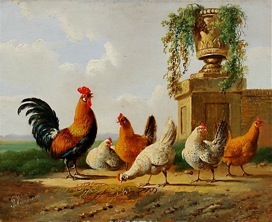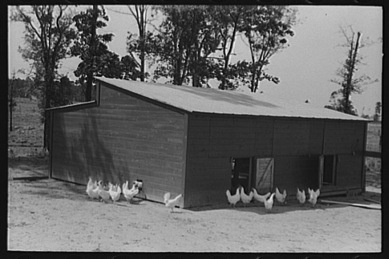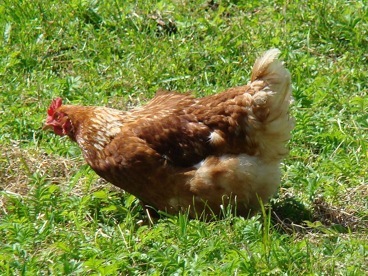Gallus gallus domesticus
, the domestic chicken, is believed to have originated over 10 millenia ago. The actual origin of today’s near flightless chicken has many theories tied to it, however, genetic information seems to point to southeast Asia as the birthplace of the lineage. The natives would have been raising these fowl for undoubtedly their meat, eggs and feathers. The population of this species has since increased exponentially due to human involvement and current estimates place the population at 25 billion. That’s almost 4 chickens to every person on the planet!
Environment
The domestic chicken’s habitat in no way resembles the habitat of its ancestors. These chickens are grown exclusively in farms, the majority in mega-farms. Ever since domestication, the
environment of these organisms has been at the sole discretion of the farmers who raise them. For thousands of years, as long as chickens have been raised, their owners have had to keep them from predation. Many different species of predators from foxes, wolves, cats, to dogs have taken advantage of this living situation. This situation led to chickens being kept in small houses, or coops, for their protection. Free-range chickens, or chickens grown in more natural settings are becoming commonplace as the trend for a less corporate view of poultry production has grown. Controversy has been raised in recent years over the treatment of chickens and cattle in these mega-farm situations. It’s very interesting and an excellent topic for debate.
Diets Of And With Chicken
Gallus gallus domesticus
is easily one of the most consumed food items worldwide. Different cultures have many different ways of consuming the domestic chicken. Fried, grilled, in stews and soups, it’s very difficult to find a menu without this fowl on it. As far as chickens themselves, they are fed mainly on diet of seeds and grains. This diet can vary slightly based on what the chicken is being raised for. The diet can be different for chickens being raised exclusively for egg laying versus a chicken being raised exclusively for meat. Interestingly, the diet of the chicken can be inferred by the color of the yolk. Take a look next time you eat breakfast! A chicken which has been fed a constant diet of wheat will produce an egg with a lighter, creamy-yellow yolk. A diet consisting largely of corn will have a bright golden yolk. The eggs cooking on the left are from a chicken with a corn-based diet.
The Chicken Itself and Interactions
The domestic chicken has a body shape very similar to many of the other Aves. That being said, they are one of the few birds who seem to have found difficulty attaining successful flight. They have a stature averaging between 30 and 45 cm (approximately one foot to a foot and a half). They typically weigh between two and six pounds. It could be inferred that a wild chicken would have a mass on the low end of this range. Mating can occur year round, and the fertilized eggs are typically incubated by the hen for approximately three weeks. Average lifespan of a domestic chicken ranges close to 5 years of age. The vast majority of chickens raised for consumption don’t come close to this age.
Being that the domestic chicken is often kept in very close contact with other chickens in potentially unsanitary conditions, numerous bacteria and other pathogens can wreak havoc with the chicken. To combat this, chickens are routinely fed antibiotics and other precautionary additives in their food to ensure the flock stays healthy on the whole. In regards to chicken-chicken interactions, they are actually very social animals. They will almost always flock together with other chickens. There are typically several female hens and a dominant cockerel (rooster).




